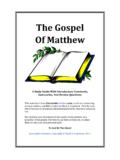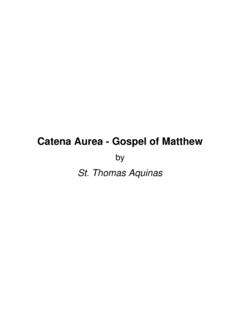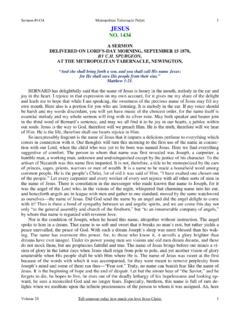Transcription of Matthew
1 1 Matthew : A Study Guide Johanna H. van Belle and the Samobistus 2 3 Matthew : A Study Guide Johanna H. van Belle and the Samobistus Shoreline Christian School 2400 Northeast 147th Street, Shoreline, WA 98155-7324 4 Photographs by Gerald van Belle 5 CONTENTS I 7 9 Matthew 13 Matthew 17 Matthew 23 Matthew 27 Matthew 31 Matthew 51 Matthew 61 Matthew 71 Matthew 77 Matthew 81 Matthew 87 Matthew 91 Matthew 95 Matthew 103 Matthew 107 Matthew 111 Matthew 115 Matthew 119 Matthew 125 Matthew 129 Matthew 133 Matthew 139 Matthew 143 Matthew 147 Matthew 159 Matthew 169 Matthew 179 183 6 7 A Study of the Gospel of Matthew For more than three decades a group of people from the Seattle First Christian Reformed Church has come together at 7 on Saturday morning to pray, eat.
2 And study the Bible. They say goodbye promptly at 8:30 and go off to do their duties for the day. Lately the time has shifted to 7:30 9:00 in favor of those who are getting on in age. Different people have attended at different times, but there was always a kernel that showed up throughout the years, week after week. John Tibbits was one of those people. He made many lessons and always gladly shared his faith, his love for Jesus, and his wisdom. David Gronlund was another person who shared his insights and put together questions. He studied the commentaries of Matthew Henry and made everyone think. Both John and David were called home by the Lord in July 2011. They made their own lessons. Their discussions would go deep. They enjoyed fellowship and shared their joys and sorrows. This book is a collection of questions and comments by the group.
3 The questions were most useful if studied before the meeting but we must confess we often saw the questions for the first time during the meeting. The questions and comments were compiled by Johanna van Belle. We had to think of a name for the group and came up with SAMOBISTUS (Saturday Morning Bible Students); the name coined at the time that the Sandinistas were active in Central America. Ordinarily we used the New International Version ( ) of the Bible but had access to many other translations that were sometimes helpful in making a passage clearer. We tended not to use commentaries when developing the questions. You can print the material one lesson at a time or print the whole book. We have left spaces between the questions so that you can write your answers in them. The nice things is that if you don t like your answers you can just print a new page.
4 The book will be useful for both individual and group study. This study of Matthew is free for anyone to use. If you use this material and feel so inclined, we would suggest you make a contribution of $ per person in memory of John Tibbits and David Gronlund to the Tuition Help Fund of Shoreline Christian School (2400 Northeast 147th Street, Shoreline, WA 98155-7324; ). If you have comments, suggestions, or edits please contact me at On behalf of the SAMOBISTUS, Johanna H. van Belle 8 9 Matthew Introduction The Gospel of Matthew was written in Greek. Matthew is concerned with the fulfillment of the Old Testament. Matthew s main theme is the messianic position of Jesus, who is seen as the fulfillment of Old Testament predictions with special emphasis on His kingship. (The New International Dictionary of the Christian Church, J.)
5 D. Douglas, Editor, page 948. (NIDCC)) Matthew is especially concerned with the Law ( The Old Testament). In the gospel of Matthew Jesus did not come to destroy the Law but to fulfill it and moreover He went beyond it to bring out the true spiritual implications of the Moses said,.., but I say. (NIDCC, page 948). Although Matthew s readers were mainly Jews he does not restrict his gospel to Jews. For example, he records the visit of the Magi and he gives a full statement of the Great Commission. Matthew was a tax collector. In Mark and Luke he is called by the name of Levi. He was one of the 12 disciples. The Gospel of Matthew contains five great discourses of Jesus. Each discourse is concluded with the words: When Jesus finished these (Note: Verses and chapters were not introduced until 1200 ) Section Start End Topic Feature I 1:1 2:23 Infancy narrative Prologue Infancy and Return from Egypt II 3:1 7:29 Proclamation of the Kingdom Discourse 1: Sermon on the Mount III 8:1 11:1 Ministry and Mission in Galilee Discourse 2: Missionary Discourse IV 11:2 13:53 Opposition from Israel Discourse 3: Parables Discourse V 13:54 18:35 Jesus, the Kingdom, and the Church Discourse 4: Church Order Discourse VI 19:1 25:46 Ministry in Judea and Jerusalem Discourse 5: Eschatology Discourse VII 26:1 28:20 Passion and Resurrection Passion and Resurrection Epilogue 10 Date The books of the New Testament are not arranged in chronological order.
6 In general, the letters of Paul are the earliest written documents available to the young church (beside the Old Testament). If you were to arrange the material in order (somewhat of a guess) you would get the following order according to the Before 50 James 50 to 59 1 Thessalonians 2 Thessalonians 1 Corinthians 2 Corinthians Galatians Romans 50 to 80 Mark Mathew Luke 60 to 69 Colossians Acts Ephesians Philippians Colossians Philemon Titus 1 Timothy 2 Timothy Hebrews 1 Peter 2 Peter Jude After 69 John 1 John 2 John 3 John Revelation The NIV has a very wide range of dates for the gospel of Matthew , considering either the early 50 s or late 60 s depending on the view whether Matthew had the gospel of Mark in front of him. ( Matthew and Luke share large sections with Mark). The consensus is that Matthew and Luke were written after Mark thus pointing to a later date.
7 11 I. INFANCY NARRATIVE Matthew 1:1-2:23 12 13 Matthew 1 Read Matthew 1 Background Matthew focuses on Joseph in Chapter 1, while Luke focuses on Mary in his first two chapters. 1. Genealogy. Read Luke 3:21-38 and compare with Matthew 1:1-17 Which two prominent people are mentioned in :17? 2. What was the promise to Abraham? read Gen. 12:3; 28:18. 3. What was the promise to David? see II Sam. 7:12; Ps. 89:3, 4. 4. What is the point that Matthew is trying to make? 5. What event precedes the genealogy of Jesus in Luke? 6. What does Luke emphasize? 7. Why, in your opinion, is it important to mention both aspects? 8. Verses 1-17 Name the outsiders mentioned in Matthew s list. 9. How significant was Manasseh s reign(verse 10); read II Kings 24: 3-4. 14 10. Verses 18-19 What was Joseph s right under the Mosaic/Levitical law?
8 ; see Deut. 22:23, 24. 11. What was Joseph s plan? 12. What does that tell us about the adopting father of Jesus? 13. Does God still speak through dreams? 14. How would we know that it is God speaking, and not our own psyche going wild? 15. Verse 21. Look back at verse 18. How do we connect the two names: Jesus and Christ? What do they mean? 16. Verses 22-25. Read Isa 7: 14. Who prophesied, to which king, about a virgin conceiving? 17. What would be the name of the son? What does it mean? 18. Who was the final fulfillment of this prophesy? Read also Isa. 9:6, 7. 19. The name Mary is the Greek version of the Hebrew, Miriam. Who was a famous Miriam in the Old Testament? 15 20. Did Mary have other children? See Mark 6:3. 21. Some branches of Christianity celebrate the Annunciation on March 25.
9 Should Mary have a special place of honor in the Christian calendar? Notes 1. Matthew focused on God s faithfulness. Fulfillment sometimes takes a long time. 2. Luke emphasizes Jesus relationship with the human race. 3. Matthew follows the line of Joseph, the legal father of Jesus; Luke follows the line of Mary, the blood relative of Jesus. 4. Tamar read Gen. 38; Rahab read Joshua 2; 6:22-25; Ruth, the Moabite read the story of Ruth. 5. Jesus because He will save His people from their sins Christ means, The anointed one. 16 17 Matthew 2 Read Matthew 2 Background King Herod the Great reigned from 37- 4 He was appointed by the Roman Senate. He was ruthless, a murderer and yet he was brilliant. He killed his wife, three of his sons, his mother-in-law, his brother-in-law, the innocent boys in Bethlehem, and numerous others.
10 He was an architect. He erected theaters, monuments, pagan altars, fortresses, and rebuilt the temple for the Jews. This last project was started in 19 and was finished 68 years after his death. 1. Verses 1-8 The foretold the birth of the Christ in Bethlehem. Read: Ruth 1: 1-2; 1:19, 22; 4:16-22; I Sam. 16:1; Micah 5: 1-2. This expectation was verbalized in John 7: 42-44. What is the importance of establishing Jesus birth in a geographical place (Bethlehem) and in historical time (King Herod the Great)? 2. Who are the Magi? Do we know how many there were? Why did they come? 3. Why would King Herod be disturbed by their questions? 4. How does Herod the Great go about to find out if there is any truth to their story? 5. How did they get their information? 6. King Herod evidently puts more faith in the , prophesies than the chief priests and the teachers of the law.






